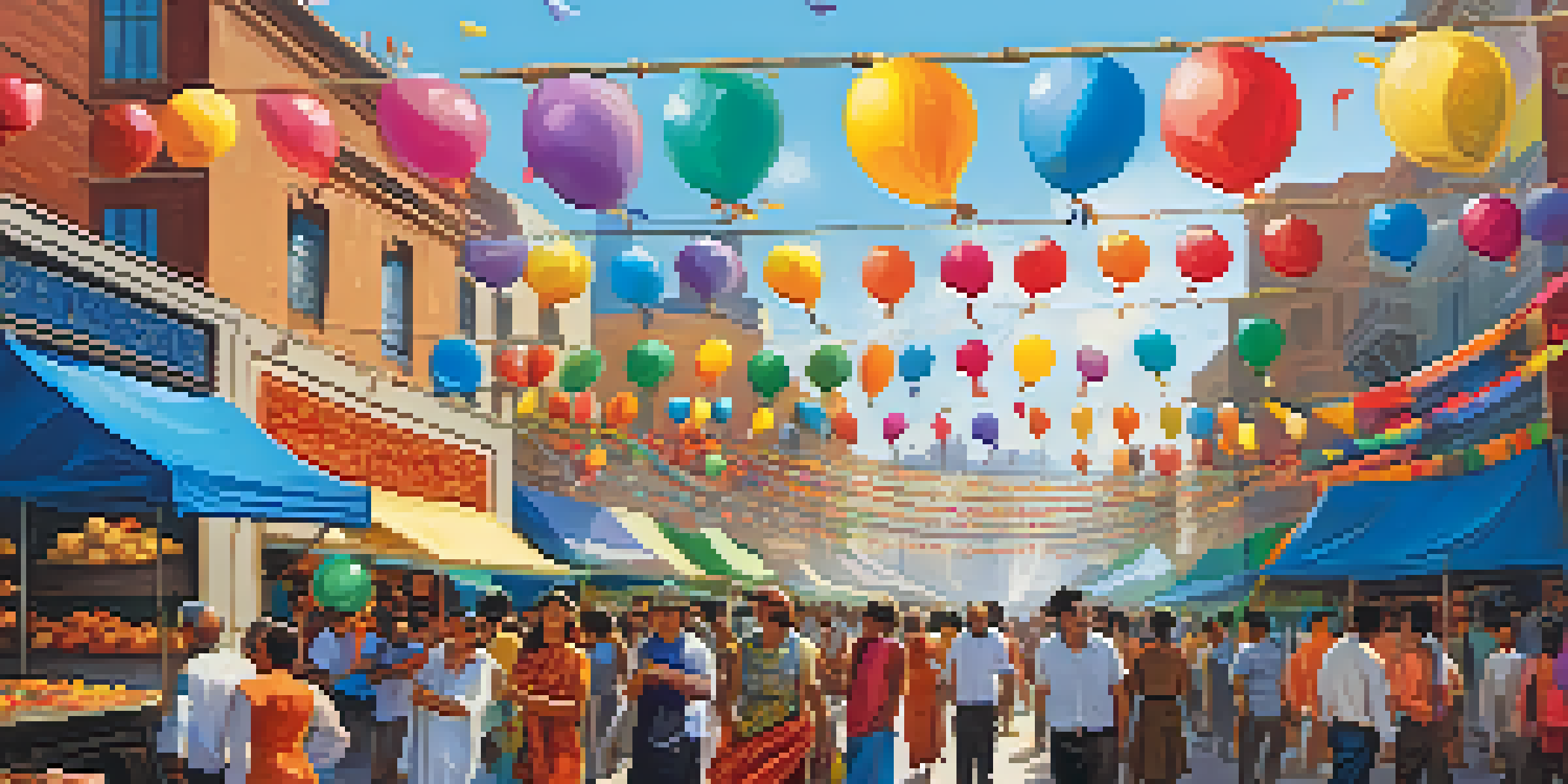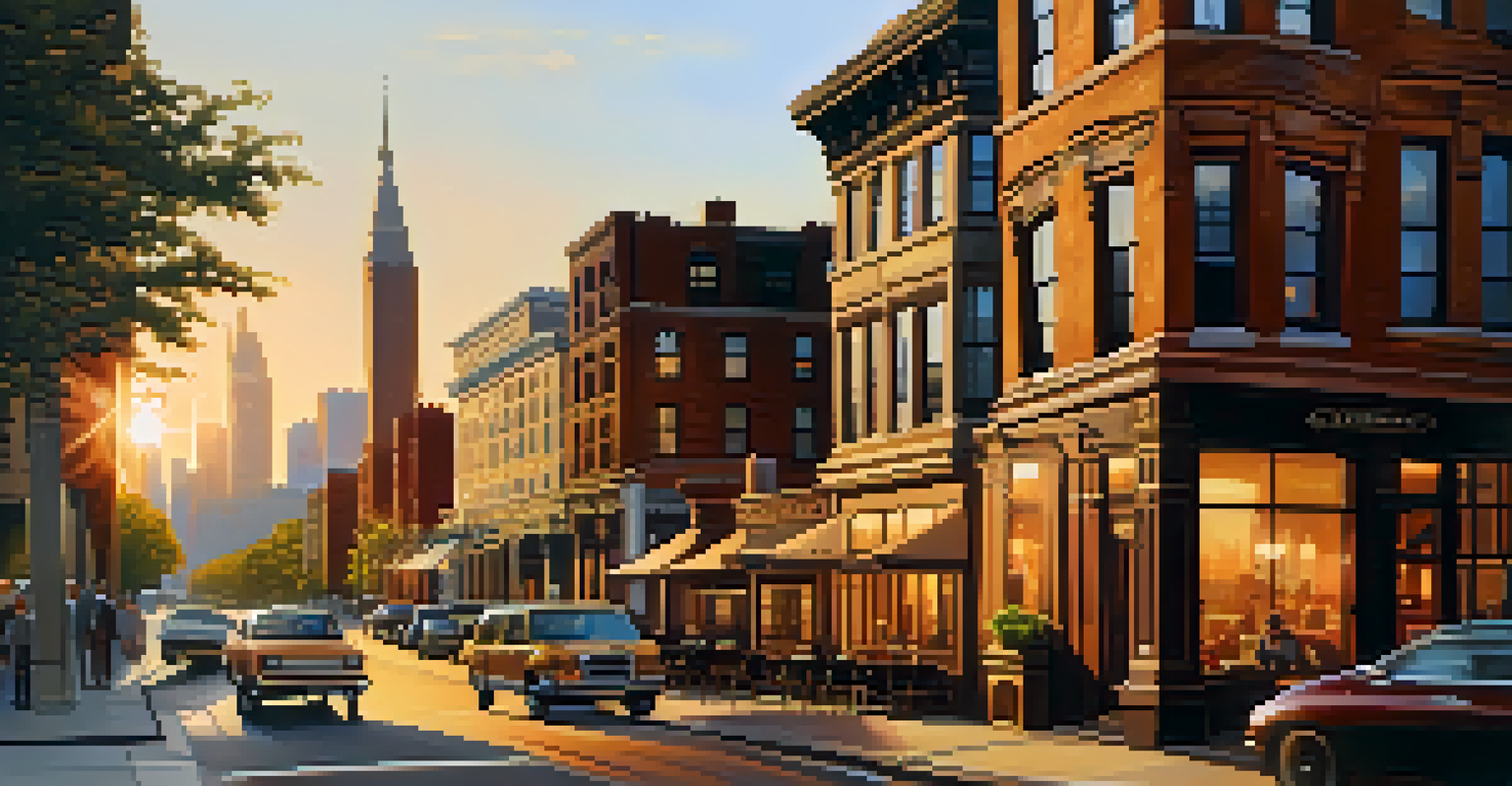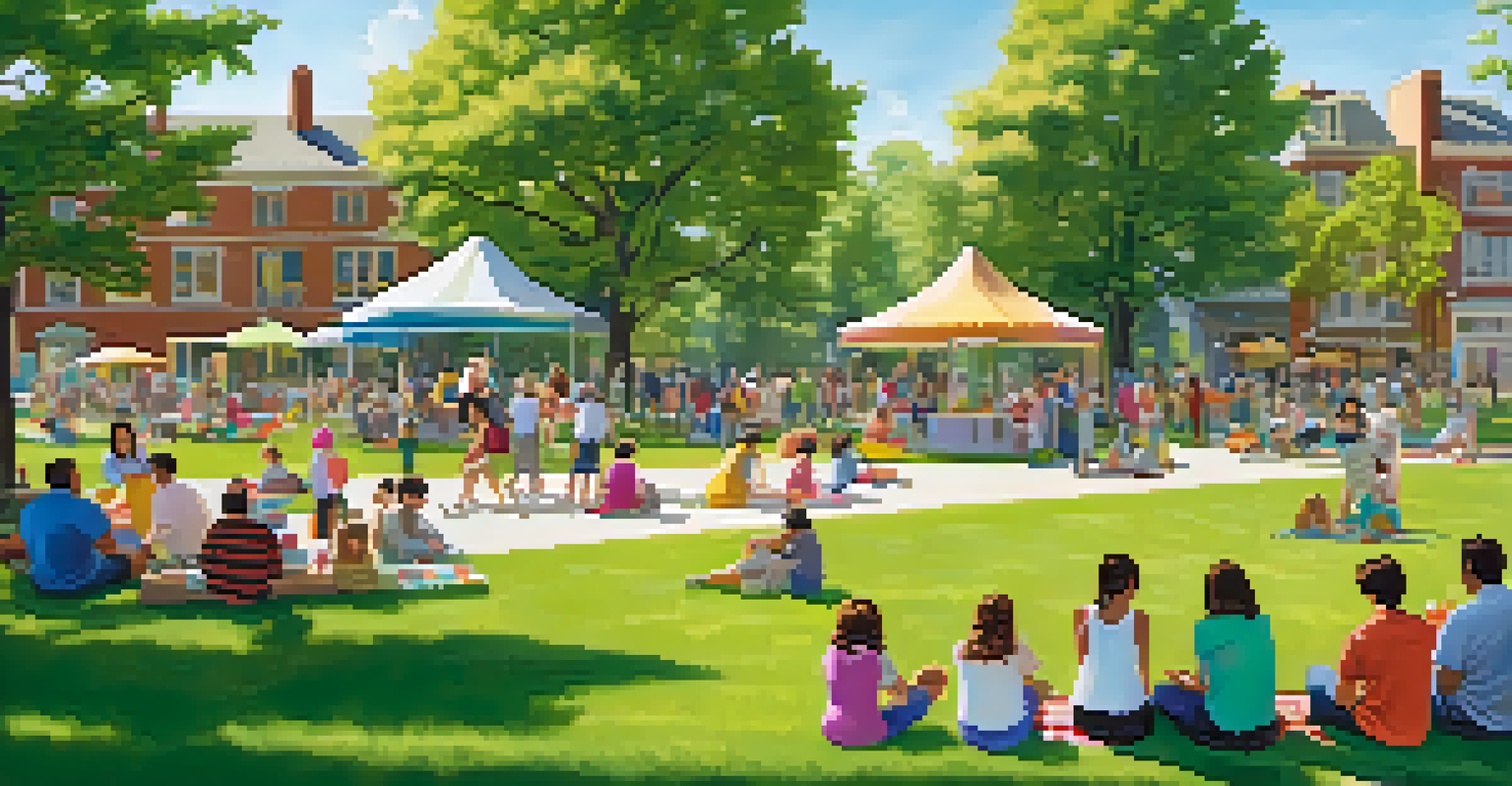Exploring Urban Landscapes: The Charm of City Life

The Vibrant Pulse of City Life
City life is often described as a vibrant tapestry, woven with the threads of diverse cultures, sounds, and sights. The bustling streets, filled with a mix of locals and visitors, create an energy that is hard to replicate elsewhere. Just imagine walking down a busy avenue, where every corner reveals a new story waiting to unfold, from street performers showcasing their talents to food vendors offering delicious local bites.
The city is not a concrete jungle, it is a human zoo.
This dynamic environment fosters a sense of belonging, as people from all walks of life come together, sharing experiences and creating memories. For instance, attending a street festival can make you feel as if you’re part of something larger than yourself, where laughter and joy are shared among strangers. It's in these moments that the city truly comes alive, and you can feel the pulse of urban life.
Moreover, cities are constantly evolving, adapting to the needs and desires of their inhabitants. This fluidity not only makes city life exciting but also encourages innovation and creativity. Whether it's a new art installation popping up in a park or a trendy café opening in an unexpected location, urban landscapes are ever-changing, inviting exploration and discovery.
Architectural Wonders and Aesthetic Diversity
One of the most enchanting aspects of urban landscapes is their architectural diversity. From historic buildings that whisper tales of the past to modern skyscrapers that reach for the sky, each structure contributes to the city’s unique character. For instance, walking through a neighborhood filled with brownstones can evoke a sense of nostalgia, while a stroll past sleek glass towers showcases contemporary design at its finest.

This blend of styles creates a visual feast that can inspire awe and curiosity. It’s fascinating how these different architectural elements come together, often in unexpected ways. Just think about how a quaint café might be nestled beside a cutting-edge tech firm — this juxtaposition reflects the multifaceted nature of urban life.
City Life: A Cultural Tapestry
Urban environments foster a vibrant mix of cultures, experiences, and communal interactions that create a unique sense of belonging.
Moreover, architecture in cities often serves a greater purpose beyond aesthetics. Iconic buildings can become landmarks, providing a sense of identity and pride for residents. They also tell stories of the city’s history and aspirations, inviting both locals and tourists to engage with their surroundings on a deeper level.
Culinary Adventures in the City
Cities are often a melting pot of culinary delights, offering a rich tapestry of flavors and cuisines. From food trucks serving fusion dishes to fine dining establishments showcasing gourmet creations, there’s something to satisfy every palate. Imagine wandering through a vibrant market, sampling everything from spicy tacos to artisanal cheeses, each bite telling a story of the city’s diverse heritage.
Cities are the greatest creations of humanity. They are the places where we create and exchange ideas, and where we find the energy to pursue our dreams.
Dining in the city is not just about the food; it’s also about the experience. Restaurants and eateries often reflect the local culture, creating spaces where food lovers can connect. Picture yourself sharing a meal with friends at a rooftop restaurant, enjoying breathtaking views of the skyline while savoring delicious dishes crafted from fresh, local ingredients.
In addition to traditional dining, street food culture thrives in urban areas, providing an authentic taste of city life. These quick, accessible bites often introduce culinary innovation, allowing chefs to experiment and push boundaries. Whether you’re grabbing a slice of pizza on the go or indulging in gourmet food stalls, each meal becomes a mini-adventure in its own right.
Public Spaces: The Heart of Urban Interaction
Public spaces are the lifeblood of cities, offering areas for relaxation, recreation, and social interaction. Parks, plazas, and waterfronts serve as communal hubs where people gather to unwind, exercise, or simply enjoy the outdoors. Think about how a sunny day in the park can transform into a spontaneous picnic with friends or a lively game of frisbee with strangers.
These spaces also host events that bring the community together. From open-air concerts to farmers’ markets, public areas become vibrant settings for cultural exchange and celebration. Engaging in these activities not only enriches our lives but also fosters a sense of community, making cities feel more welcoming.
Architectural Diversity Inspires
Cities showcase a blend of historic and modern architecture that not only enhances visual appeal but also tells stories of their evolution.
Moreover, well-designed public spaces can encourage inclusivity and accessibility. Features like playgrounds, seating areas, and walking paths invite people of all ages and backgrounds to connect with their environment. This connectivity is essential for cultivating a strong urban community, where everyone feels they belong.
Cultural Experiences: Museums and Theaters
Cities are often cultural epicenters, brimming with museums, galleries, and theaters that celebrate creativity and history. Visiting a local museum can be a captivating journey through time, where art and artifacts narrate the story of a city’s evolution. For instance, a stroll through an art gallery can spark inspiration and conversation, as you immerse yourself in the works of local artists.
Theater and performance arts also thrive in urban environments, providing entertainment and thought-provoking experiences. Whether it’s a Broadway show or an indie play, each performance offers a unique glimpse into the human experience. Imagine the anticipation in the air as the curtain rises, drawing you into a world of storytelling and emotion.
Moreover, cultural institutions often host events and workshops, inviting the community to participate and engage. This interaction cultivates a love for the arts and creates a platform for emerging talents. By supporting local artists and performers, cities strengthen their cultural fabric, making urban life all the more enriching.
Navigating the Urban Jungle: Transportation Options
Navigating city life can initially feel overwhelming, but urban areas often boast a variety of transportation options that make getting around easier than you might think. From subways and buses to bike-sharing programs and rideshares, there’s a mode of transport to suit every preference and need. Imagine hopping on a train during rush hour, where the energy of fellow commuters energizes your day.
Public transportation not only enhances accessibility but also promotes sustainability. By opting for buses or trains, you’re contributing to reducing traffic congestion and lowering carbon emissions. Cities are increasingly investing in eco-friendly transit solutions, showcasing their commitment to a greener future.
Sustainable Trends in Urban Living
Innovations in smart technology and sustainability are shaping the future of urban living, encouraging community engagement and eco-friendly practices.
Additionally, the rise of walkable neighborhoods encourages residents to explore their surroundings on foot. This not only fosters a deeper connection to the city but also unveils hidden gems that might otherwise go unnoticed. Picture discovering a charming bookstore or a cozy café just a few blocks from your home, making every stroll an adventure.
The Future of Urban Living: Trends and Innovations
As cities continue to grow and evolve, they are also embracing trends and innovations that shape the future of urban living. Smart city technology, for instance, integrates digital solutions to improve efficiency and enhance quality of life. Imagine a city where traffic lights adapt to real-time conditions, making your commute smoother and reducing wait times.
Sustainability is another key trend, with urban planners prioritizing green spaces and eco-friendly initiatives. Cities are transforming rooftops into gardens, creating urban farms that not only provide fresh produce but also foster community engagement. This shift toward sustainability reflects a growing awareness of our environmental impact and the importance of preserving urban ecosystems.

Moreover, community-driven projects are becoming more prevalent, empowering residents to take an active role in shaping their neighborhoods. From participatory budgeting to local art installations, these initiatives encourage collaboration and creativity. As a result, cities are not just places to live; they are vibrant ecosystems where residents can influence change and contribute to a shared vision for the future.